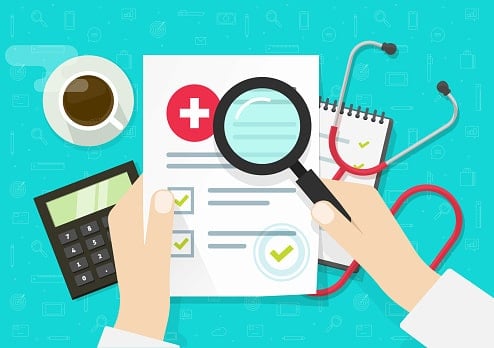How much is health insurance in 2025?
How much you pay for health insurance depends on where you get your coverage and what type of policy you choose. While the average cost of an ACA plan is $497 a year, that's based on a benchmark plan, which is the second-lowest-priced Silver plan for a single 40-year-old.
For that same person, a bronze plan would cost $381 a year, while a Gold plan averages $507 a year. These are both for the lowest-priced plans available at each tier.
If you get your insurance through your employer, however, the numbers look different. That's because your employer carries part of the cost. On average, people pay $8,951 a year for a single person and $25,572 a year for a family. It's important to note that these rates can't be compared apples-to-apples with ACA rates since they encompass all employer-based health plans, from the cheapest to the most expensive.
What influences employer-based health insurance costs?
Most people get their health insurance through their employer.
When determining health insurance premium quotes, health insurers gather information from employers, including employee ages, the employer’s industry and the past year of employee medical claims.
"They generally consider the average age and gender of the employee,” says Gary Franke, owner of Achieve Alpha Insurance. “For example, women in their childbearing years are more expensive to insure but so are older men in their 50s or 60s, who are more prone to having a heart attack, stroke or other major issues.”
If your health insurance went up, this might be why. Employer plan premiums tend to increase year-over-year based on the prior year's expenses.
“So if your employer group is healthier than average in the prior year, the monthly price you and your employer will pay will go up by less," adds Franke.
Group plans are also commonly priced using "composite rate quoting," according to Marshall Darr, vice president of marketing and a licensed broker with Decent, a health insurance administrator.
"An employer submits the ages for all employees and their dependents. The carrier then provides a single rate that averages out the risk across the company, so that everyone pays the same," Darr explains. "But companies that skew older will have more expensive premiums."
The type of health plan also influences costs, including premiums and deductibles.
The most common employer-sponsored health plan is a preferred provider organization (PPO) plan, which usually costs more than a health maintenance organization (HMO) plan. PPO plans often have similar deductibles.
Meanwhile, a high-deductible health plan (HDHP) usually has much lower premiums than PPOs and HMOs, but much higher deductibles. You pay a deductible for health care services before a health plan chips in. A high deductible means you’ll pay more when you need care than if you had an HMO or PPO.
Another factor that goes into employer-sponsored costs is how much the business pays. Employers usually pay more than half of health insurance premiums, but that can vary.
What influences ACA plan costs?
Individual health plans and plans on the Affordable Care Act’s Health Insurance Marketplace request key information from people when determining health insurance costs.
"Health insurance costs will vary significantly depending on your age, geography, family status and tobacco use," notes Brian Martucci, a personal finance expert with Money Crashers.
Plans can’t reject you or charge higher rates because of pre-existing conditions. The ACA ended that practice.
"Generally speaking, young, healthy non-smokers enjoy the lowest health insurance premiums, while older adults pay more – especially on the individual market," says Martucci.
Chris Orestis, the president of Life Care Xchange and a nationally recognized healthcare expert, echoes those thoughts.
"Our current system rewards people for being younger and healthier in both group or individual coverage. But the differences are much starker for individual coverage," says Orestis.
Darr says the ones who tend to pay the most overall are older folks who don't yet qualify for Medicare – such as 64-year-olds.
Franke says individual plan insurers can only charge an older person three times what it charges a younger person.
However, younger people tend to pay a higher relative premium every month for an ACA plan than older people, Franke notes.
"The problem is that younger people, in general, are more likely to go without insurance, since it is expensive relative to the cost. ACA insurance carriers need more younger people to even out the expenses of older people, so they charge younger policyholders more than they should be paying," says Franke.
How your health plan affects health insurance costs
The type of plan you choose also influences ACA plan costs. People with ACA plans through the Health Insurance Marketplace can choose a Platinum, Gold, Silver, or Bronze plan. The plans differ by premiums and out-of-pocket costs.
Here are the differences:
Bronze
- Lower premiums than other ACA plans
- Higher deductibles and out-of-pocket costs when you need care than the other ACA plans
- Plan covers 60% of health care costs and you pay the other 40%
Silver
- Higher premiums than Bronze, but lower premiums than Gold and Platinum
- Higher deductibles and out-of-pocket costs than Gold and Platinum, but less than Bronze
- Plan covers 70% of your health care costs and you pay the other 30%
Gold
- Higher premiums than Bronze and Silver, but lower premiums than Platinum
- Higher deductible and out-of-pocket costs than Platinum, but less than Bronze and Silver
- Plan covers 80% of your health care costs and you pay the other 20%
Platinum
- Higher premium than any other plan
- Lower deductibles and out-of-pocket costs than any plan
- Plan covers 90% of your health care costs and you pay the other 10%
How income affects health insurance rates
There’s another factor in what you pay for an ACA plan – your income. You can qualify for subsidies that lower your monthly premiums based on your income compared to the federal poverty level (FPL). In 2025, $15,650 for an individual or $32,150 for a family of four. If your income is 250% FPL, you must only pay up to 4% of your household income toward healthcare premiums.
If your FPL is 400% or higher, you pay no more than 8% of your household income on healthcare premiums.
Kaiser Family Foundation offers a tool that estimates health insurance costs for a marketplace plan.
How your state affects health insurance costs
Where you live and your state of residence can also affect what you pay for individual insurance and an ACA plan.
"Many states have taken steps in recent years to stabilize their internal health insurance markets and drive down premiums," Martucci says. "For instance, at least 10 states – including Minnesota, Oregon, New Jersey, Maryland and Wisconsin – have established or applied to establish reinsurance funds that cover a portion of high-cost claims, easing the burden on insurers."
Darr adds that states also run their own health insurance exchanges and can make decisions about insurance matters, including when to make special open enrollment periods available.
Health insurance finder tool

COBRA
Learn more about COBRA
How much is your annual household income?
How many members are in your household?
Medicare
Medicare costs vary depending on which option you choose.
Learn more about Medicare costs.
Medicaid

Parent's employer-sponsored health insurance

Spouse's employer-sponsored health insurance

Employer-sponsored health insurance

Preferred-provider Organization (PPOs)
Preferred-provider organization (PPOs) plans are the most common type of
employer-based health plan. PPOs have higher premiums than HMOs and HDHPs, but
those added costs offer you flexibility. A PPO allows you to get care anywhere
and without primary care provider referrals. You may have to pay more to get
out-of-network care, but a PPO will pick up a portion of the costs.
Find out more about the differences between plansHealth maintenance organization (HMO)
Health maintenance organization (HMO) plans have lower premiums than PPOs.
However, HMOs have more restrictions. HMOs don't allow you to get care outside
of your provider network. If you get out-of-network care, you'll likely have to
pay for all of it. HMOs also require you to get primary care provider referrals
to see specialists.
Find out more about the differences between plansHigh-deductible health plans (HDHPs)
High-deductible health plans (HDHPs) have become more common as employers look
to reduce their health costs. HDHPs have lower premiums than PPOs and HMOs, but
much higher deductibles. A deductible is what you have to pay for health care
services before your health plan chips in money. Once you reach your deductible,
the health plan pays a portion and you pay your share, which is called
coinsurance.
Find out more about the differences between plansExclusive provider organization (EPO)
Exclusive provider organization (EPO) plans offer the flexibility of a PPO with
the restricted network found in an HMO. EPOs don't require that members get a
referral to see a specialist. In that way, it's similar to a PPO. However, an
EPO requires in-network care, which is like an HMO.
Find out more about the differences between plans
Learn more about individual insurance plans
Sources:
- Kaiser Family Foundation. “2024 Employer Health Benefits Survey.” Accessed August 2025.
- Kaiser Family Foundation. “Health Insurance Marketplace Calculator.” Accessed August 2025
- Kaiser Family Foundation. “Average Marketplace Premiums by Metal Tier.” Accessed August 2025.













